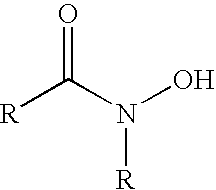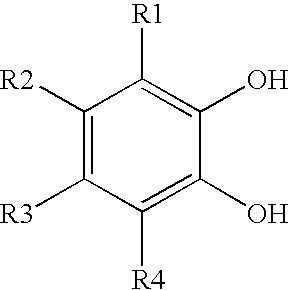Derivatized nanoparticle comprising metal-ion sequestrant
a technology of metal-ion sequestrant and derivatized nanoparticles, which is applied in the direction of synthetic resin layered products, natural mineral layered products, non-contaminated water treatment, etc., can solve the problems of release of chemicals that are harmful to the user of said items, metals that are toxic to living systems, and organisms that may experience disease or illness, etc., to achieve efficient removal of metal-ions, high capacity for metal-ions, and convenient application
- Summary
- Abstract
- Description
- Claims
- Application Information
AI Technical Summary
Benefits of technology
Problems solved by technology
Method used
Image
Examples
example 1
[0044] A iron-sequestering suspension was prepared by the addition of 2.89 g derivatized nanoparticles A (0.5 g dry particles) to 7.11 g distilled water. To this suspension was then added 2.0 ml of a 500 ppm (parts per million) solution of Fe(NO3)3. The suspension was stirred for about 10 minutes and then filtered under-pressure through a dialysis filter having a molecular weight cut-off of 20,000 g / mol. The filtration effectively removes the nanoparticles and anything bound to them from the suspension. The recovered supernatant liquid was then examined for Fe concentration via inductively coupled plasma-atomic emission spectroscopy. The results are reported in Table 2.
example 2
[0045] Performed in an identical manner to example 1, except that 2.38 g derivatized nanoparticles B (0.5 g dry particles) and 7.62 g distilled water were used in place of the derivatized nanoparticles A and distilled water. The results are reported in Table 2.
Comparison Example C-1
[0046] Performed in an identical manner to example 1, except that 1.00 g of chelex 100® (Biorad) and 9.00 g distilled water were used in place of the derivatized nanoparticles A and distilled water. The results are reported in Table 2.
example 3
[0047] A “model” biological liquid medium was prepared as follows: 12.5 g of sucrose, 12.5 g of glucose, 0.25 g of NaCl and 0.125 g of citric acid, and 16.0 ml of a 500 ppm solution of Fe3+ were carefully dissolved in 484.0 ml of pure distilled water to produce a solution having: 5% sucrose, 5% glucose, 1000 ppm NaCl, 500 ppm citric acid and 16 ppm iron. The pH of the model beverage was adjusted to 4.0 with the addition of a few drops of 1.0 N NaOH. To 8.8 ml of the model beverage above was added 0.58 g derivatized nanoparticles A (0.10 g dry particles). The suspension was stirred for about 10 minutes and then filtered under-pressure through a dialysis filter having a molecular weight cut-off of 20,000. The filtration effectively removes the nanoparticles and anything bound to them from the suspension. The recovered supernatant liquid was then examined for Fe concentration via inductively coupled plasma-atomic emission spectroscopy. The results are reported in Table 2.
PUM
| Property | Measurement | Unit |
|---|---|---|
| particle size | aaaaa | aaaaa |
| particle size | aaaaa | aaaaa |
| particle size | aaaaa | aaaaa |
Abstract
Description
Claims
Application Information
 Login to View More
Login to View More - R&D
- Intellectual Property
- Life Sciences
- Materials
- Tech Scout
- Unparalleled Data Quality
- Higher Quality Content
- 60% Fewer Hallucinations
Browse by: Latest US Patents, China's latest patents, Technical Efficacy Thesaurus, Application Domain, Technology Topic, Popular Technical Reports.
© 2025 PatSnap. All rights reserved.Legal|Privacy policy|Modern Slavery Act Transparency Statement|Sitemap|About US| Contact US: help@patsnap.com


